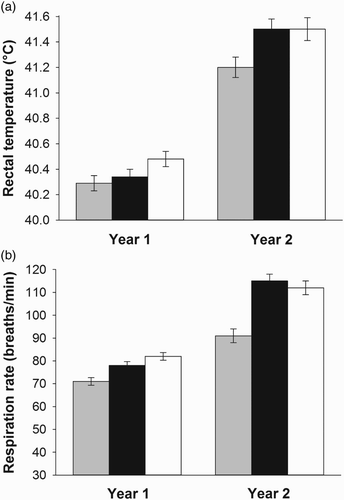Figures & data
Table 1. Mean (±SEM) concentrations of endophyte alkaloids (mg/kg) in ryegrass herbage measured in 2012 in paddocks sown with different cultivar-endophyte combinations (n=3 per cultivar), in which lambs were grazed from 14 February to 2 April 2012.
Table 2. Mean (±SEM) concentrations of endophyte alkaloids (mg/kg) in ryegrass herbage measured in 2013 in paddocks sown with different cultivar-endophyte combinations (n=3 per cultivar), in which lambs were grazed from 1 February to 21 March 2013.
Figure 1. Mean (±SEM) liveweight gain (g/day) of lambs grazing pastures sown with different cultivar-endophyte combinations (n=30 per cultivar) for 48 days in February and March in (a) 2012 (Year 1) and (b) 2013 (Year 2). The cultivars were endophyte-free Trojan ryegrass (grey bars), Trojan ryegrass infected with NEA endophytes (black bars), endophyte-free Samson ryegrass (coarsely striped bars), Samson ryegrass infected with standard endophyte (S-STD, white bars) and Samson ryegrass infected with AR37 endophyte (finely striped bars). Note that in 2013 liveweight gain was not determined for the S-STD group because all animals were removed before Day 48 due to severe staggers.

Table 3. Number of lambs categorised by ryegrass staggers score (Keogh Citation1973) on two occasions in 2012, that were grazing different cultivar-endophyte combinations between 14 February and 2 April 2012.
Table 4. Number of lambs categorised by ryegrass staggers score (Keogh Citation1973) on four occasions in 2013, that were grazing different cultivar-endophyte combinations between 1 February and 21 March 2013.
Figure 2. Mean (±SEM) (a) rectal temperature (°C) and (b) respiration rate (breaths/minute) of lambs when subject to heat stress after grazing pastures sown with different cultivar-endophyte combinations (n=30 per cultivar) for 24 days in 2012 (Year 1) and 26 days in 2013 (Year 2). The cultivars were endophyte-free Trojan ryegrass (grey bars), Trojan ryegrass infected with NEA endophytes (black bars) and Samson ryegrass infected with standard endophyte (white bars).

